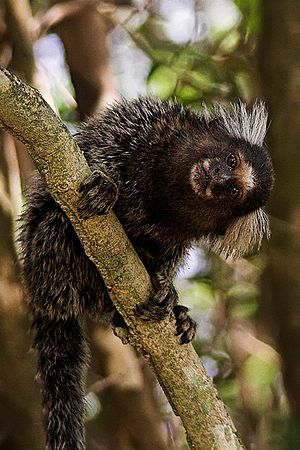Marmoset facts for kids
Quick facts for kids Marmosets |
|
|---|---|
 |
|
| Common marmoset (Callithrix jacchus) at Tibau do Sul, Rio Grande do Norte | |
| Scientific classification | |
| Kingdom: | Animalia |
| Phylum: | Chordata |
| Class: | Mammalia |
| Order: | Primates |
| Suborder: | Haplorhini |
| Infraorder: | Simiiformes |
| Parvorder: | Platyrrhini |
| Family: | Callitrichidae |
| Groups included | |
|
|
| Cladistically included but traditionally excluded taxa | |
|
|
Marmosets are small, active monkeys that live in the forests of South and Central America. They are part of a group called New World monkeys, which means they live in the Americas. There are 22 different kinds of marmoset species. They all belong to the same animal family called Callitrichidae. The Goeldi's marmoset is also very similar to other marmosets.
Contents
What Makes Marmosets Special?
Marmosets are usually about 20 centimeters (8 inches) long. Compared to other monkeys, they have some unique features. Instead of nails, they have claws on their fingers and toes. They also do not have wisdom teeth.
Body and Brain
Their brains are also a bit different from other monkeys. Marmosets can change their body temperature quite a lot. It can go up or down by as much as 4 °C (7 °F) in a single day. This helps them adapt to different temperatures in their environment.
Where Marmosets Live
Marmosets are originally from South America. You can find them in countries like Bolivia, Brazil, Colombia, Ecuador, Paraguay, and Peru. They have also been seen in parts of Central America. They love living high up in the trees of the forest.
Unique Genetics
Marmosets have a very special genetic trait called germline chimerism. This means that two different individuals can share cells, especially in their reproductive systems. This is very rare in nature, especially among primates. Marmosets are one of the only groups of primates where this happens naturally.
Marmoset Life and Habits
Marmosets are very active animals. They spend most of their time in the upper parts of forest trees. They are always busy looking for food and interacting with their family groups.
What Marmosets Eat
Marmosets eat a variety of foods. Their diet includes insects, fruit, and leaves. They have long lower incisors, which are their front teeth. These teeth help them chew holes in tree trunks and branches. They do this to get to the sticky gum inside the trees. Some marmoset species are experts at finding and eating this tree gum.
Marmoset Family Life
Marmosets live in small family groups. These groups usually have between three and 15 members. A typical group might include one or two females who have babies, a male who is not related to them, their young, and sometimes other family members or unrelated individuals.
Reproduction and Family Groups
The way marmosets form pairs and have babies can vary a lot. Some groups might have one male and one female who mate (this is called monogamy). Other groups might have one male mating with several females (called polygyny). Sometimes, one female might even mate with several males (called polyandry). This flexible family structure helps them survive in their forest homes.

